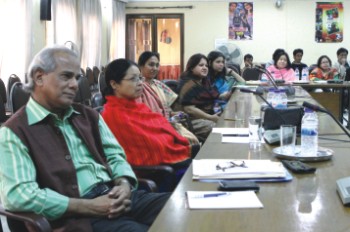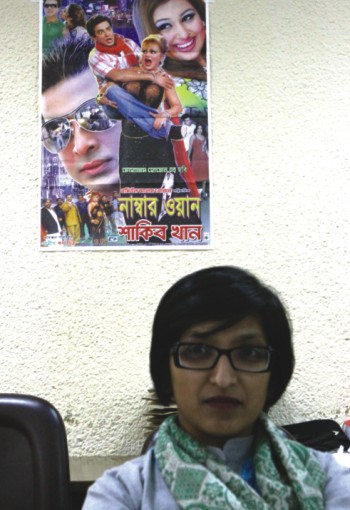Media
Women and TV
Anika Hossain
“We should break the stereotypes that are portrayed in the media: married women are always shown busy with making a home and tending to children, the good wife is shown as someone looking after her in-laws and tolerating all manner of in justice, dark women are constantly shown trying to become fair and pretty, all this should change and new images and stories of women need to be depicted.”
 |
Panelists participating in the Roundtable.
Photo: Zahedul I Khan |
This statement, obtained from female students of Jahangirnagar University contradicts the popular belief that people, especially women absorb everything they watch on television and allow what they see to influence their lives. The modern Bangladeshi woman has come a long way. She is no longer just a homemaker, invisible to the outside world. She has stepped out of her home and is studying, working achieving new heights of success in her career.
To discuss the relationship of today's Bangladeshi woman and the media, a roundtable was organised by the Pathways of Women's Empowerment Research Programme at BRAC Development Institute (BDI) on 22 December 2010.
The daylong roundtable discussion titled “Women and Visual Media: Representation and Engagement,” featured two research presentations about women's experience with watching television. Samia Afroz Rahim, Research Associate at the Pathways Programme at BDI, made the first presentation on a research titled “Women Watching Television: Surfing Between Fantasy and Reality.” The research shows how Bangladeshi women engage with television, the meaning they derive from the various programmes they watch and how they adopt certain elements and incorporate them into their lifestyles and discard others, which seem alien to them.
The sample populations were women between ages of 15 and 45 from different economic and social backgrounds, occupations, marital status and locations. Most of these women belonged to lower-middle and the lower class of the social strata and were either housewives, students, day labourers, garment workers and domestic help. The researchers also interacted with middle class university students who are going through major changes in their lives.
The research was qualitative and involved conversations with these women. The researchers also watched television with them and their families to observe the relationship dynamics in their households and their reaction to the content on TV.
The findings were extremely interesting. They found that in most households, women had to negotiate their television viewing time with the rest of the family members. Most families shared one television and women mostly watched TV in the afternoons. When male members of the family were present, they took over the TV.
 |
While some women look for aspects of their lives in TV shows,
others watch shows which take them away from reality. Photo: Zahedul I Khan |
These women watch serials on Indian and Bangladeshi channels, which mostly depict family lives of various different classes of society. Decorum is maintained between the male and female members of the family. For example, in a lower middle class family, the women will leave the room if there is an intimate scene being shown on TV when the men are present. Age determines the content, which can be viewed by these women. Older women are allowed to watch much more. Marital status also plays a role in this. Married women have a license to watch what they believe is inappropriate for young unmarried women.
However, unmarried college students have a different opinion. They believe sex before marriage is becoming more common in our society. One young interviewee said, “ Sex is a part of life. Among those of us who are at university and having affairs, many are having physical relationships. This is no longer an era where women remain virgins until marriage.” Some women consider the media an educational resource for learning more about sex.
The researchers also found that most of these women are interested in watching the news. They want to know what is going on in their country and the effect the political climate will have on their lives.
Women belonging to the Hindu religion prefer watching Indian channels because they portray their daily lives and religion more than Bangladeshi channels. While some women look for aspects of their lives in TV shows others look for shows that will take them away from reality, into a fantasy life they can only dream about.
The main finding of the research was that through television, women from all over the country experience a whole new world of possibilities. They absorb things they think are relevant to their lives and try to translate them into reality.
The second presentation, made by Shahida Khondokar, also a Research Associate at Pathways, was titled “Pahari Media O Nari.” This research explored the visual media viewed by the Chakma communities in the Chittagong Hill Tracts and the influence of cultural activists in the region.
Researchers found that the Chakma communities produce their own serials and dramas on DVDs because they do not find their language, culture and history depicted in Bangladeshi channels. However, they enjoy watching both Bangladeshi and Indian channels as well. They find these channels useful to learn the Bengali language, which is important to them.
They also enjoy watching and learn Rabindra Sangeet at home and on TV. The researchers watched some shows with these families and found that the plot of these tribal shows and films are similar to those seen in Dhaliwood movies. “Apart from the outfits, the content is pretty much the same,” says Khondokar.
The researchers watched TV with Chakma women and found that although they believe that Bangladeshi television does not represent them properly, they still support the national sports teams and watch the news because it is important for them to support their country. Bengalis may marginalise them, but they still see this country as their own.
The panelists opined that Chakma women are often portrayed as submissive in their shows and films. A woman is not portrayed as a decision maker unless she is elderly and the head of a household. They believe that it is important for the media to show the modern tribal woman on TV. The educated, independent and self-reliant tribal women they have come to be.
The successful roundtable ended with a closing panel, which discussed new directions in research and media studies. Media personalities, activists, academics, researchers and practitioners all participated in the discussion, trying to shape policies and strategies for the future of the media in Bangladesh.
Among the participants were Professor Ferdous Azim from BRAC, Kaberi Gayen, Associate Professor, Dhaka University, Munni Saha, ATN News, Mahtab Haider, Independent TV, Sara Zaker, Nayantra Communications, Mahmudul H Sumon, Associate Professor, Jahangirnagar University, Sanjib Drong, Bangladesh Adibashi Forum, Saymon Zakaria, Folklorist and Playwright, Professor Helal Uddin Khan Arefeen, Dhaka University, Asif Saleh, Drishtipath, Rokeya Rafique, Kormojibi Nari and Muhammad Jahangir, Center for Development and Communications.
Copyright
(R) thedailystar.net 2010 |
